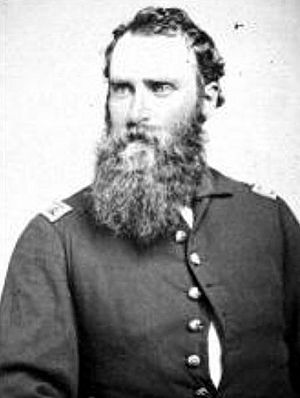Charles Henry Tompkins facts for kids
Quick facts for kids
Charles Henry Tompkins
|
|
|---|---|

Charles Henry Tompkins
|
|
| Born | September 12, 1830 Fort Monroe, Virginia, U.S. |
| Died | January 18, 1915 (aged 84) Washington, D.C., U.S. |
| Place of burial |
Oak Hill Cemetery
Washington, D.C., U.S. |
| Allegiance | United States of America Union |
| Service/ |
United States Army Union Army |
| Years of service | 1856-1861 1861-1894 |
| Rank | |
| Battles/wars | |
| Awards | Medal of Honor |
Charles Henry Tompkins (born September 12, 1830 – died January 18, 1915) was an American officer. He served as a Union Army colonel during the American Civil War. He was later given an honorary rank (called a brevet) of Brigadier General.
Tompkins received the Medal of Honor for his bravery. This award was for his actions on June 1, 1861, at the Battle of Fairfax Court House (June 1861). He was the first Union Army officer to earn the Medal of Honor for a Civil War event. However, he did not actually receive the medal until 1893.
Contents
Who Was Charles Henry Tompkins?
Charles Henry Tompkins was born in Fort Monroe, Virginia, on September 12, 1830. His father, Daniel D. Tompkins, was also an Army officer. Charles was also the grand-nephew of Vice President Daniel D. Tompkins.
He attended West Point, a famous military school. He left West Point in 1849 before finishing his studies. For a few years, he worked in private business.
In 1856, he joined the army as a private soldier. He rose through the ranks to become a sergeant. He served in the western parts of the country. He was recognized for his actions at the Second Battle of Pyramid Lake in June 1860.
Military Service During the Civil War
In March 1861, Charles Tompkins became a 2nd lieutenant in the 2nd U.S. Cavalry Regiment. He was promoted to 1st lieutenant on April 30, 1861. It was with this unit that he became famous for his bravery. This happened during the Battle of Fairfax Court House (June 1861).
On August 3, 1861, he moved to the 5th U.S. Cavalry Regiment. He worked as the regimental quartermaster, which meant he managed supplies. In April 1862, he became a colonel of the 1st Vermont Cavalry. He left this volunteer position in September 1862.
During the war, he received several honorary promotions, known as brevets. These included major, lieutenant colonel, colonel, and brigadier general.
Life After the Civil War
After the war, Tompkins was one of nine officers chosen for a special military group. This group investigated the people involved in the assassination of President Lincoln.
He had some disagreements with General Grant. Because of this, from 1866 to 1881, he was sent to many distant army posts in the western United States.
He spent the rest of his career in the Quartermaster Corps. This part of the army handles supplies and logistics. He rose to the rank of Assistant Quartermaster General in 1881. This position came with the rank of colonel in the Regular Army. He retired from the army on September 12, 1894.
Charles Henry Tompkins passed away on January 18, 1915, in Washington, D.C.. He is buried at Oak Hill Cemetery in Washington, D.C.
Family Life
Charles Tompkins married Augusta Root Hobbie in New York on December 17, 1862. They had seven children together, and four of them lived to adulthood.
His oldest son, Selah Reeve Hobbie Tompkins, also became an Army officer. He rose to the rank of Colonel in the 7th Cavalry Regiment. Another son, Colonel Frank Tompkins, was also a career army officer. He was known for his part in the raid on Columbus, New Mexico, by Pancho Villa. He also joined the Punitive Expedition that followed. For his actions, he received the Distinguished Service Cross.
See also

